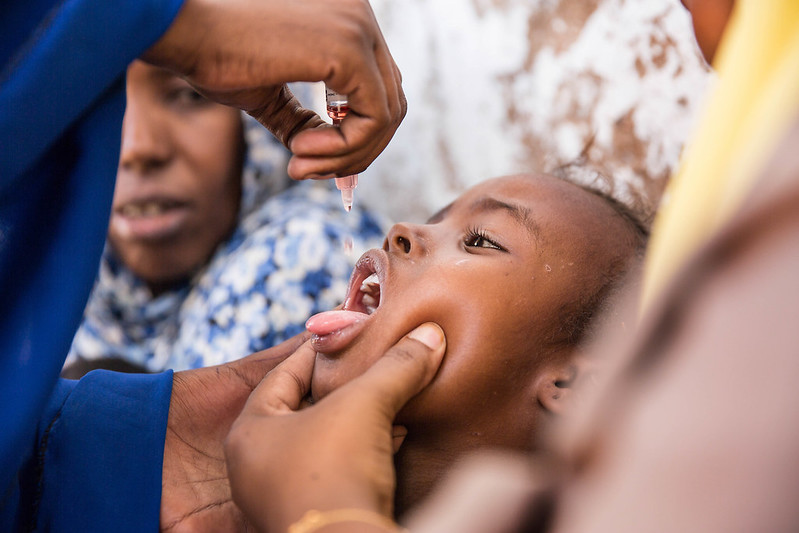So far 187 cases of polio have been reported in Nigeria in 2021. Source (WHO)
What is Polio?
Poliomyelitis is a viral infection that mainly affects children under the age of 5 years, it can be fatal and lead to lifelong paralysis. The Poliovirus are of three types (Type 1, Type 2 and Type 3) with Type 3, being the most dangerous. Polio becomes fatal when it affects the muscles that are responsible for breathing. More than 5% of cases where polio affects muscle responsible for breathing lead to death.
What are the symptoms of polio?
Who is at risk of polio?
Children under the age of 5 are most at risk of getting infected with polio, also they are more prone to developing lifelong paralysis from the infection.
How does polio spread?
Polio spreads mainly through;
- Faecal oral route: the poliovirus mainly enters the body through the mouth and is spread through the infected person’s faeces.
- Through contaminated food and water.
- Through saliva droplets from an infected person when then sneeze or cough.
What are the types of Polio?
There are three types of wild polio;
Abortive Poliomyelitis (Type 1)
Abortive polio is a mild form of polio that does not cause paralysis as it does not affect the central nervous system. They rather present flu-like symptoms that last a couple of hours to a few days.
Symptoms of abortive polio include;
- Sore throat
- Headaches
- Vomiting
- Fever
Nonparalytic Poliomyelitis (Type 2)
nonparalytic polio, just like abortive polio does not affect the central nervous system and do not lead to temporal or permanent paralysis although the symptoms are more severe compared to Type 1 abortive polio, the symptoms last up to 10 days.
The symptoms of nonparalytic polio include;
- All symptoms of abortive polio
- Fatigue
- Malaise
- Meningitis
Paralitilitic Poliomyelitis (Type 3)
Paralytic polio occurs 1 in every 200 cases of polio and leads to irreversible paralysis. It affects the central nervous system or the brainstem or both. More severe cases affect the muscles that are responsible for breathing. 5% to 10% of cases where the muscles responsible for breathing are paralysed leads to death. Source (WHO)
The symptoms of paralytic polio include;
- All symptoms of abortive and nonparalytic polio.
- Stiffness of the neck and pain in the limb.
- Loss of reflexes
- Paralysis could be temporal or permanent.
- Deformed limbs
Circulating vaccine-derived polioviruses (cVDPVs)
The polio vaccine is a weakened poliovirus that is introduced into the body, it cannot harm the body rather serves as an immune booster when the live poliovirus infects the body. This vaccine after serving its purpose of alerting the immune system is excreted out of the body. In a community where there are few vaccinated people, this weakened poliovirus gets transmitted from person to person through the faecal-oral route. On the onset, this is advantageous as it helps boost the immunity of many but after circulating for so long (12 – 18 months) in a population of low immunity and low vaccination the virus mutates into that which can begin to attack the nervous system and cause paralysis
In Nigeria, between October 10 to October 17 2021, 18 new cases of circulating vaccine-derived polio Type 2 had been confirmed, 1 in Adamawa, 1 in Gombe, 1 each in Katsina and Taraba, 2 in Borno and 6 each in Jigawa and Kano. bringing the total so far in 2021 to 187 reported cases. Source (WHO).
How is Polio Diagnosed?
To diagnose polio your doctor would physically examine you for any of the above symptoms, followed by a lab test. In the laboratory, samples of your stool, cerebrospinal fluid and swab from your throat would be tested for the presence of the poliovirus.
What is the Treatment for Polio?
There is no cure for polio. But the disease can be managed to make the infected person more comfortable by doing the following;
- Taking in fluids like; (Juice, water and intravenous fluid)
- The use of ventilators to aid breathing.
- Non-steroid and anti-inflammable painkiller medications.
- The use of heat lotions to soothe the muscles.
How can polio be prevented?
To prevent polio, you must;
- Practice good hygiene.
- Avoid contaminated water and food.
- Get vaccinated: the goal is to get every child vaccinated against polio, this will help eradicate polio from our communities.

